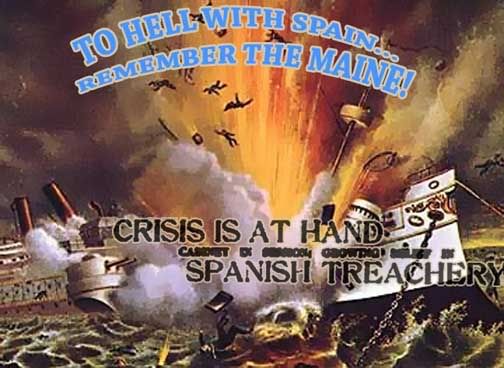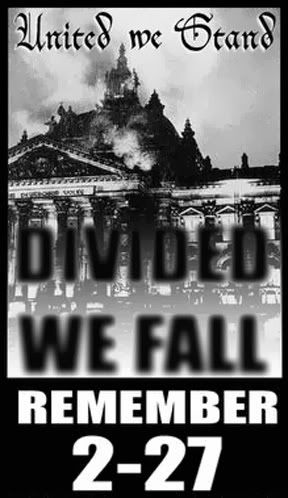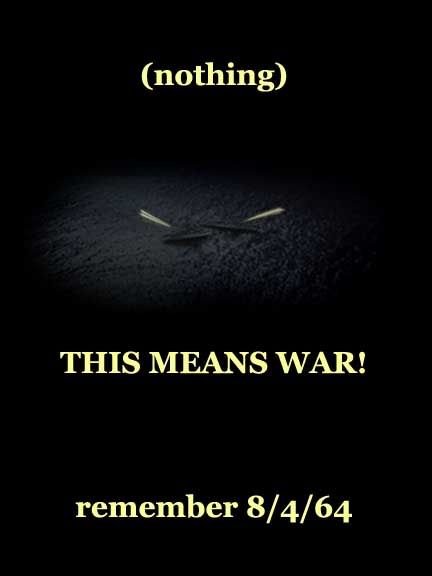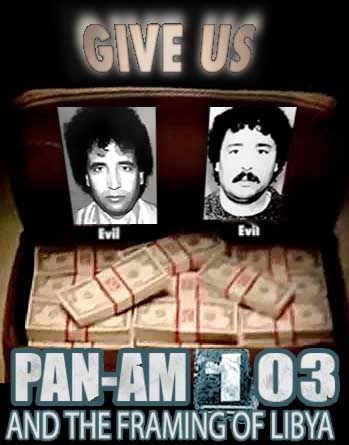Adam Larson / Caustic Logic
April 16 2009
working copy - incomplete
This post, to be updated regularly, will condense various evidence supporting the tentative hypothesis of a previous post The One That Got Away? Essentially, it's a look at the circumstantial evidence for a second, and belligerent war ship in the vicinity of the Liberty prior to its attack - the provoker and cause of the troubles that fell on the American kids. Considering the possibly explosive nature of this, questions about the sources and verification, and lack of previous studies on it (that I know of), I'm forced to be deeply intrigued. And as I look, I'm uncannily confirmed that there's something more than coincidence at work here. Following are the four operative aspects: seriousness of shelling reports, claims of two ships in the vicinity (Israeli Defense Force reports), second ship evidence from Liberty crew, and finally the puncher: speed and heading "errors" in what's supposed to have been the Liberty's track. At the end, a graphic summation. If there weren't at least two separate target ships involved in this episode, someone is trying to make it appear so.
1) SERIOUSNESS OF SHELLING REPORTS
From the IDF Ram Ron Report, 6/16/67:
"At 11.24 a.m. a message was received from the Command Post and by the Air Force that El-Arish was under bombardment from the sea. This message was transmitted on the basis of a message received from the Southern Command and had been repeated several times - based on repeated similar messages from the Southern Command.
[...]
These messages when reported to Capt. Rahav by Comm. A. were received by him with reservation and he insisted that they be re-examined. […] Together with his demand that the information regarding the shelling be verified, Capt. Rahav instructed Comm. A. at 12.05 p.m. to order three torpedo boats then stationed at Ashdod and ready to sail, to head in the direction of El-Arish in order to investigate the information received. Lieut. Comm. P. re-investigated the information regarding the shelling with the Naval Forces Command Post and was informed again that the Southern Command reports that El-Arish is under bombardment from the sea…
[…]
At 13.17 p.m. Comm. S. (representative of the Naval Force at the Command Post) advised Comm. A. that El-Arish had been under bombardment for the last four hours. Following this message, Comm. A. ordered Comm. AR. - Division Commander/Torpedo Boats - to examine the area at approximately 20 miles north of El-Arish.”
From Col. Uri Algom, The Attack on the "Liberty" Incident: 8 June 1967. IDF History Department, 1982. Posted here.
"At 1124 hours, the naval representative at Air Command reported to Naval Operation Section/3, on the shelling of El-Arish from the sea, Commander Lunz passed on the report to Chief of Naval Operations, Captain (Navy) Rahav, and he to turn instructed Lt. Commander Pinchasi, in no uncertain terms, to check the source of the report. The inquiry into the source of the report was ordered because of the many reports which had been received concerning shelling from the sea and which were later proven to be false, The feeling was that this report was probably no different. Lt. Commander Pinchasi was told by Air Operations Section/3 that the source of the report was an Air-Ground Support Officer in El-Arish; the Navy representative at the Supreme Command, Lt. Commander Tel, also informed Lt. Commander Pinchasi that a similar report had been received enquiry to Naval Operations/3.
Meanwhile the shelling of the coastline also aroused interest at Supreme Command. The Head of Operations Section, Lt, Colonel Haim Nadel, (during a meeting with the COS at 1127 hours), received a report from G Branch- Southern Command, stating that a ship had been shelling El-Arish but the shells had not reached the coast. The Head of Operations Section immediately ordered that the report be verified, and more important instituted a check to see if there were no Israel Navy vessels off the coast of El-Arish. [...] These reports were passed to Fleet Operations Control Center - to Commander Lunz and Captain (Navy) Rahav. The accumulation of reports from various sources and the involvement of Supreme Commend in the matter, indicated that these reports were not baseless and should be taken seriously."
Michael B. Oren, The USS Liberty: Case Closed. Azure. Spring 2000:
"Then, at 11:24, a terrific explosion rocked the shores of El-Arish. The blast was clearly heard by the men on the Liberty's bridge [...] In El-Arish itself, Israeli forces were convinced they were being bombarded from the sea [...] Though the explosion probably resulted from an ammunition dump fire, that fact was unknown at the time [...there was] good reason to conclude that the Egyptian navy had trained its guns on Sinai."
Captain McGonagle, testimony to Naval Court of Inquiry:
“[I]t was possible to see a large billowing cloud of black smoke rising from approximately 15 to 20 miles to the west of El Arish on the beach. The exact identity of the cause and the location of this explosion is not positively known, although it was believed to be near the beach in that area. This was noted at about 1300. At about 1330 a smaller cloud of black smoke was noted to the east of El Arish estimated five to six miles and also along the coastline."
Two separate plumes miles apart does not sound like a simple ammunition dump fire. It's interesting to note Israeli command seemed confident the explosions were caused by a vessel north of El Arish, while the Liberty, on the scene in that area seemed oblivious to any such presence near them. The danger was distant, but noted by the Captain at about 1:45 as the drill wrapped up, about 10-15 minutes before the first strafing run across the deck:
"Before dismissing the crew from general drills, I gave the crew a short talk on the PA system, reminding them of the importance of expeditiously responding to general quarters and the setting of condition Zebra for drills and in the event of an actual attack. So that they would be impressed I pointed out to the crew at that time that the column of black smoke on the beach should be sufficient evidence that the ship was in a potentially dangerous location.”
2) TWO SHIPS IN THE VICINITY (IDF REPORTS)
Of course, any explicit mention of a ship seen or known to be shelling indicates a ship capable of that, in addition to the Liberty. With that in mind:
From the Yerushalmi Report, 7/21/67:
"It is to be noted that the reports from Southern Command [re: shelling] were also accompanied by information that two vessels had been observed approaching the coast."
From Algom, IDF, 1982:Note: The Liberty was approaching the coast, obliquely from the east, until 11:30, and then turned slightly away. If any report specifying "two ships" came in, it could be concocted, out of caution or something else, from duplicate but differing sightings of the lonely Liberty. It's also possible they originated with an aerial reconnaissance round that observed both the Liberty and a specific second ship, or even two mystery ships aside from her, thus confidently reporting "two ships." Another possibility:
"The Head of Operations Section, Lt, Colonel Haim Nadel, (during a meeting with the COS at 1127 hours), received a report from G Branch- Southern Command, stating that a ship had been shelling El-Arish but the shells had not reached the coast. [...] Meanwhile, another report arrived from Southern Command (at 1145 hours), which stated that two ships were approaching the EL-Arish coast."
Ram Ron Report:
"Said messages also contained reports on two ships or one ship shelling El-Arish [...] Naval Forces Command Post and was informed again that the Southern Command reports that El-Arish is under bombardment from the sea and that two ships can be seen at a distance."
Very important bit from Oren's article I missed at first indicates there was at least a brief moment the Motor Torpedo Boat commander felt there were two ship in the area, worked out for a separate post:
On their way there, the MTB crew say they felt they were racing towards an Egyptian Z-Class destroyer, based on the shelling reports, the ‘observed’ radar speed, and even initial Air Force reports in the attack. When they got to it they quickly realized that was wrong. Israeli historian Michael Oren explained how Division Commander Moshe Oen (no relation?) "could see that it could not be the destroyer that had supposedly shelled El-Arish. Rather, he believed, it was a slower-moving vessel that had either serviced that destroyer or evacuated enemy soldiers from the beach.” Thus any second thoughts this gave them were quickly corrected – it was just a different Arab ship. The important but overlooked corrolary of this is the IDF’s jets had already spent twenty minutes attacking the wrong vessel and the 30-knots shore attacker was slipping away behind the distraction. This seems, from the records I've examined (all available) to have been no concern of the IDF, as they continued their attack against the easy mark in lieu of a threat they seemed to know never really existed.
3) POSSIBLE SECOND SHIP REFERENCE (USS LIBERTY)
This is certainly the weak point of this theory: no eyewitness or radar reports of any suspicious ship zipping at 30 kts through their space. As mentioned in the original piece, Survivor Richard Carlson wrote this, which might be a clue, vague as it is:
"I had finished lunch, and now standing by the starboard railing, began talking with CT1 Bingham. He looked as nervous as I felt. We tried to console each other that we were basically an unarmed ship, in international waters, and that no one was going to bother with us. Neither of us sounded convincing. We couldn't seem to shake the mystery ship following us. Who was it we wondered?"
That's just nothing much to go on. I'm starting a separate post to explore primary sources on what 'the ship' as a whole might have seen. Nothing yet about any steel-and-oil mystery ship, but a little more room than I thought for it to hide in, hypothetically at least, and some useful information otherwise.
4) SPEED AND DIRECTION "MISCALCULATION"
From the US State Department, Salans Memorandum, 9/21/67:Note the target in question was first sighted at 1341, a fact communicated back to headquarters. What would cause this ship to change direction shortly after discovery? "Whiskey Tango Foxtrot, you are on the scopes now. Depart the area, full speed."
"As you requested, we have compared the decision of the Israeli Judge, dated July 21, 1967, with the findings of the U.S. Navy Court of Inquiry, and the Clifford Report, concerning the Liberty incident. The following discrepancies are noteworthy:
I. Speed and Direction of the "Liberty"
The Israeli report indicates that the torpedo boat Division Commander reported and reconfirmed the target's (Liberty's) speed at 28 to 30 knots and that it had changed its navigational direction shortly after 1341 hours.
The U.S. Navy inquiry established that the Liberty had been on a steady course at 5 knots from 1132 hours until the attack."
Ram Ron Report:
"At 13.41 p.m. the Torpedo boat's radar picked up a target at a distance of approximately 20 miles north/west of El-Arish and approximately 14 miles north of Barbville [sic]. Immediate message to the effect was passed on to Comm. A. [...] At 13.47 it was reported from the Torpedo Boats that the speed of the unidentified targets was 30 knots and their course 260. […] at 13.50 p.m. the Torpedo boats reported that the target speed was 28 knots."

Yerushalmi Report:Note the direction of change and its implications are not specified, but considering the MTB path after this discovery (see graphic below) they decided it was turning north, which it in fact did about fifteen minutes later. The MTBs themselves turned soft right/north, apparently slowed down a bit, and eventually sort of merging with the Liberty's mid-speed escape path, and strangely failed to kill everyone, as they well could have.
"According to the division log-book, a target was located at 13.41 hours situated at a distance of about 20 miles north of El-Arish. The division was ordered "to close in and identify the target," and reported that the unidentified target was moving at a speed of 30 knots westwards--that is, in the direction of Port Said.
A few minutes later, the Division Commander reported that the target, now 17 miles from him, was moving at a speed of 28 knots, and since he could not overtake it, he requested the dispatch of aircraft towards it. The Division Commander also reported that the target had changed its navigational direction."
From Algon, IDF, 1982This report was offered by the IDF as the "official" Israeli version, their chance to set the record straight with full access to the knowledge of the Israeli Defense Forces to offer the best explanation of why their equipment might misread the situation so wildly. Please carefully consider the following, which is apparently the best Algon and his staff were able to come up with:
"At 1341 hours, the Division detected the target on its radar 20 miles northwest of El Arish and 14 miles off the coast of Bardewil. The officer at the C1C on the flagship, Ensign Yifrach Aharon, reported that the target had been detected at a range of 22 miles, that her speed had been tracked for a few minutes, after which he had determined that the target was moving westward at a speed of 30 knots. These data were forwarded to the Fleet Operations Control Center.
The speed of the target detected by the Israel Naval Division was significant in that it indicated, beyond doubt, that the target was a combat vessel - since only combat ships can develop such high speeds. [...] The given data created the impression at Naval Operations of an enemy ship, turning to escape in the direction of Port Said. The Chief of Naval Operations asked the Division to double-check their calculations. A second check confirmed the direction of the target, but her speed was corrected to 28 knots."
"In retrospect, it is clear that the data dealing with target speed were incorrect since the "Liberty" was not capable of cruising at such high speeds. However, it is astounding that the same target speed was measured independently by two torpedo boats: T204 (with the Division commander aboard) and T203 which estimated target speed at 25 - 28 knots."It's "astounding," and that's comparing it to the non-sequitur top-speed of 18 knots. That's the "since." So even presuming the captain and crew and logs were all lying and she was flooring it to 18 there, a double-reading of 25-38/30 knots would be "astounding." That's pretty damn lame considering the Liberty was actually crawling along at less than a third of this, f-i-v-e nautical miles per hour, the whole time, which is the fact the author chose NOT to place after the "since." And there, ladies and gentlemen, is the IDF's best explanation. Another author using the same 'since' and nudging forth the IDF's implied whole other ship story:
Oren, Case Closed: "At 1:41 p.m., Ensign Aharon Yifrah, combat information officer aboard the flagship of these torpedo boats, T-204, informed its captain, Cmdr. Moshe Oren, that an unidentified ship had been sighted northeast of El-Arish at a range of 22 miles. The ship was sailing toward Egypt at a speed, Yifrah estimated, of 30 knots.
Yifrah's assessment, twice recalculated and confirmed by him, was pivotal. It meant that the ship could not be the Liberty, whose maximum speed was 18 knots. [...] This information, when added to the ship's direction, indicated that the target was an enemy destroyer fleeing toward port after having shelled El-Arish.
The torpedo boats gave chase, but even at their maximum speed of 36 knots [actually 42 -ed], they did not expect to overtake their target before it reached Egypt [based on the 560% wrong speed 'calculation' -ed]. Rahav therefore alerted the air force, and two Mirage III fighters were diverted [...] [and the hits just kept coming -ed]."
GRAPHIC SUMMATION
Coming back when it's corrected. Yep, I did something wrong. (Statute miles compared to nautical mils will give you 'discrepancies'). Slap head... still, it's a start towards mapping out the scene.













2 comments:
If there was a second ship (a high-speed Z class destroyer) in the area, its wide and long white-water wake should have been easily seen by the high-flying attack pilots as they approached (from the southeast according to the IDF) Liberty's location.
Also, the pilot of the small aircraft that was flying back-and-forth along the north Sinai coastline should have been able to see a second ship.
And last but not least, the NORD aircraft pilots that flew over Liberty on a regular basis should have been able to see a second ship.
With all of these eyes-in-the-sky, I doubt that a second ship would have gone unnoticed or unplotted on the IDF's war-room chart.
Hi Ken... a moment while I paste the response from another post a minute ago:
Thanks for the comment, good sir.As you may have deduced, I'm not updating this blog lately. I've become all-consumed with the Lockerbie issue, branching out to its own site. Hosetly, I forget what I decided with a second ship. My best clue for a minute was a radar location that couldn't be Liberty, but then I realized I confused statute and nautical miles. Nevermind. Otherwise what I found is that above. Not strong enough to say.
Otherwise, we're left with some dishonest radar reading. I can't buy that the Liberty (going 5, not 17 knots) could possibly be read that way on accident, twice. But then the "shelling," or explosions anyway, must be explained (Israeli paratroopers?) or... one extra ship covers it all.
And the war room might have refused to recognize the second ship, even if reported.
But I'm at least half-inclined to agree with you here. No second ship. The reports of two ships might be based on the Liberty known to be nearby, and incapable of shelling, so the shelling must be from a second ship?
And the shelling itself - there were clearly explosions, and I'm having a hard time with coincidence. I wonder if the brown plane had dropped paratroopers to manage this. It occurred to me at one point Ram Ron himself (a paratrooper, IIRC) might have headed up this operation, hence his selection to write the report.
And I'll leave it there.
Post a Comment